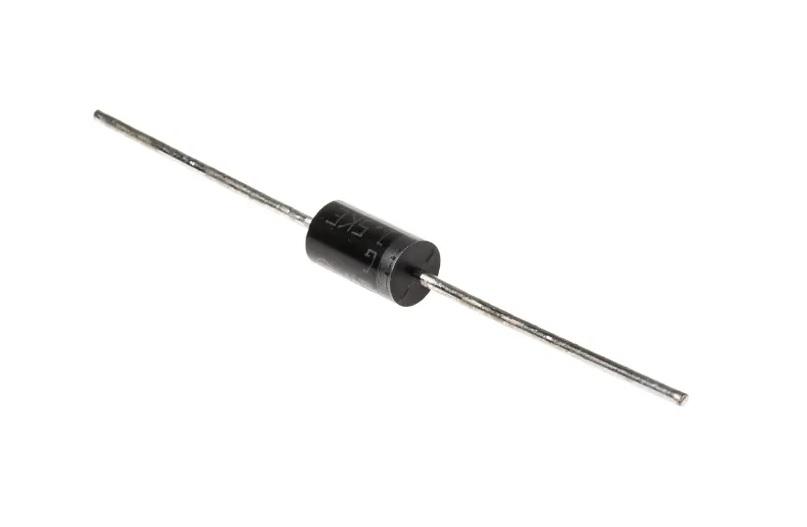Countless electrical parts are already standard in today’s automobiles. Electronic systems like these improve passenger comfort and safety while driving, but they also make one wonder how reliable the car is. Because the vehicle can cause electrical disturbances like electrostatic discharge and electromagnetic interference, electronic modules must be handle with extra care when use in an automotive setting.
What is the Purpose of a Diode?
Several rules have been established to address the electrical risks associated with contemporary vehicles. To fulfil the key obligations outlined in these standards, manufacturers and suppliers must carefully consider these criteria and build safeguards to their modules. Standard diodes are an essential safety component because they prevent other components of the vehicle’s electrical system from being damaged by outward current spikes. Their striped cylindrical design encourages unidirectional current flow and makes them ideal for usage in automobile applications.
In a car, where would you Normally find a Diode?
Theoretically, a diode—an electrical component with two semiconductor-metal terminals—allows current to flow freely in one direction while blocking it in the other. A Standard Diode is a type of electrical switch that regulates current in an electrical circuit. You can find the diode close to the alternator in an automobile. The alternator produces alternating current (AC), which is transform into direct current (DC) by approximately six diodes, so the battery and other electrical components may use it. While alternating current (AC) can change directions, direct current (DC) remains constant. Since DC is more efficient and less expensive, it is require for usage in batteries and motor vehicles.
In what Other Contexts are Diodes Use?
Photodiodes
The car industry continuously seeks new ways to enhance the driving experience for their customers. A driver’s comfort and safety can be greatly enhance by even seemingly little upgrades, such as an automatic rain sensor that activates the wipers or a light sensor that adjusts the interior and display lighting depending on the ambient light. The driver can pay more attention to the road because there are fewer controls to handle, which is a favourable element physically. A well-lit display and vehicle, on the other hand, greatly improve visibility.
One important part of many systems that automate these procedures is accurately detecting visible and invisible light. Standard Diode is commonly employe for this purpose. Photodiodes can automatically modify the brightness of an automobile’s display based on the amount of light outside, including light streaming in through the windows. The windscreen is equipped with rain sensors that use photodiodes to detect the amount of rain that has fallen on a specific area. When this amount of rain is reached, the wipers are turned on.
Diode Laser
A vital area of application in the automotive sector is joining automobile body construction. Seams on the outside must adhere to the most exacting standards of beauty. Some common examples are the connection between the roof and walls and the laser welding or brazing of aluminium in galvanised sheets and tailgates. Doors, framework, A-, B-, C-pillars, and door cut-outs are laser beam weldable using diode lasers. Additionally, a beam converter and a diode laser allow for remote welding. In addition to hardening and coating pressing tools, gearwheels, and the cam and crankshafts in the drive train, diode lasers are utilize for welding gears.
Diagnosing a Failed Diode
When most people’s cars suffer electrical problems, such as not starting, they first think of the battery. Changing the batteries could not fix the issue and could be a waste of money if the diagnostic procedure doesn’t consider the electrical system. A defective diode in the vehicle is often the root cause of battery-related issues with features like remote start, keyless entry, and start/stop systems. Another symptom of a diode problem could be electrical noise or a battery that won’t charge correctly. Electrical disturbances are causes by the diode’s failure to convert AC to DC, which in turn causes electronic device issues. A shorted diode can quickly drain a battery because of the current difficulties that allow for excessive drain. An electrical system tester and a battery can conduct a ripple test to identify irregularities, which can indicate diode difficulties.
Conclusion
Remember that many of your car’s electrical systems would only work properly if diodes were use. For instance, rectifier diodes are essential for battery charging, and Zener diodes protect delicate electrical components from overvoltage. In addition, automobile electrical systems have become more efficient and dependable thanks to developments in diode technology, which has improved fuel efficiency and decreased pollution. To sum up, Standard Recovery Diodes are vital to the automobile sector for the reliable and efficient operation of many electrical systems. So, to ensure the car is safe and reliable, you have to use diodes of good quality that are up to code.





